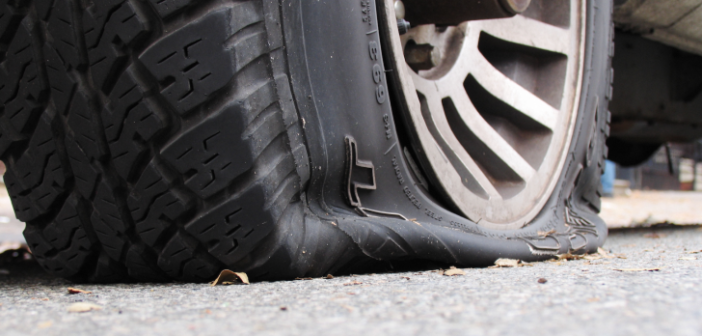It’s fashionable, hip and fun to accelerate, but slowing down that speeding hunk of metal is much more important as a second mistake might result to death or serious injuries. Any driver’s safety depends on consistent, reliable deceleration, or in other words, working brakes and tires. These two parts constantly keep your car pointed and moving – or not moving – in the right direction.
Like any car component, brakes and tires slowly wear out as the miles climb, eventually getting to the point where they become a safety hazard. To avoid dangerous situations behind the wheel, you should always be on the lookout for these telltale signs of brake or tire failure.
Underinflated or overinflated tires
Car tires work best at a specific air pressure, and filling any more or less isn’t a good idea. Under-inflation increases rolling resistance, leading to reduced fuel economy and performance. It also wears out the tread more quickly and places increased strain on the internal belts that hold a tire together.
Conversely, over-inflation shrinks the contact patch, limiting traction and stability. Over-inflated tires are more susceptible to punctures as they can’t absorb impact from road debris as effectively. It’s nearly impossible to tell if a tire is correctly pressurized just by looking at it, so it’s recommended that you check at every other gas pit-stop. Reference your owner’s manual or the sticker inside the driver’s door for the correct pressure rating.
Uneven tire wear
When everything is optimally set up, your tires should wear out at the same rate. If you notice that one is wearing differently than the others, something isn’t right. The issue could be with the tire itself, like incorrect inflation or belt separation. There might also be a suspension problem or improper wheel alignment. It’s best to have a mechanic inspect uneven tire wear to see what’s really causing the problem.
Low tread depth
Tire tread, the grooves surrounding the outside of a tire, help maintain grip and channel water and debris away from the contact patch. While tires last for thousands of miles, eventually they will wear off.
If there’s any question about the tread depth on your tires, it’s easy to check. First, find a penny (there’s bound to be one somewhere in your car), and stick it in a central groove with Abraham Lincoln’s head pointed towards the middle of the wheel. If you can see the top of his head, replace your tires.
Bulges and bubbles
Impacts against potholes and other road imperfections can pinch the tire against the rim and cause a bulge or bubble. This happens when the inner lining tears, letting air leak into the outer casing. A tire bulge is a weak point that can suddenly burst, so it’s never safe to drive on a bulging tire.
Punctures
You’re bound to get a sharp object stuck in your tire at some point. Whether it’s a nail, screw, or piece of wood or metal, if something punctures your tire it’s not good news. You might be able to use a plug or patch to close the hole, but keep in mind that punctures larger than ¼ inch in diameter or in the sidewall cannot be safely repaired.
However, if it’s a small tack, or even if it’s a long nail that enters at an angle, you may be able to pull it out and be on your way. If there’s any doubt, have a tire specialist take a look.
Squealing brakes
One of the most annoying car sounds (and in fact any sound) is brakes that squeal. Although it’s the automotive equivalent to nails on a chalkboard, the sound is intentional. It means that a brake pad is touching the brake rotor, and that your brakes need replacing.
Usually, ending the noise is as simple as installing new brake pads, with the added benefit of restoring consistent and reliable braking power. Depending on your car and driving style, brake pads can last anywhere from 25,000 to 70,000 miles.
Pulsating pedal
Braking should be drama-free, so it’s more than unnerving when the pedal feels like it’s vibrating under your foot. A pulsating or vibrating brake pedal is often caused by brake rotors that have warped due to long use or overheating. Because these warped rotors aren’t smooth, the pads can’t get a solid grip, causing that freaky pulsing. Installing new rotors should fix the problem, but first make sure you’re not dealing with a loose wheel nut or misaligned tire.
Pulls when braking
Your car’s direction is supposed to be controlled by the steering wheel. However, if your car has a collapsed brake line or stuck caliper, it might pull to the left or right when you pump the brakes. A collapsed brake line won’t evenly apply brake pressure, and a stuck caliper won’t release the rotor when you let off the pedal. Regardless of the cause, a car that doesn’t stay straight while braking is dangerous and should be repaired immediately.
Spongy or low pedal
If your brake pedal feels spongy or gets lower every time you push it, you may have a leak in the brake system. The leak may let brake fluid drip out, or allow air or water to get in. In either case, brakes are supposed to be a sealed system, and if there’s a leak it’s only going to reduce your braking ability, which is pretty much the last thing you want.
Burnt out brake light
Even if your brakes themselves working perfectly, it can be a big problem if your brake light bulbs are burnt out, and might cost you a fender bender or two. Everyone has had to deal with a driver with a dead brake light bulb-don’t let that driver be you. Make a habit of occasionally checking your brake light bulbs.
You don’t even have to get out of your car. Back up against a wall or your garage door and press the brakes. Use your mirrors and look over your shoulder to see if the lights on both sides and in your rear window light up. It’s one of the easiest ways to avoid getting rear-ended.
Given how important brakes and tires are, never ignore these problems if you spot them. If you’re not certain what’s causing a problem or what to do about it, contact a qualified mechanic who can get your brakes and tires back in good shape.




